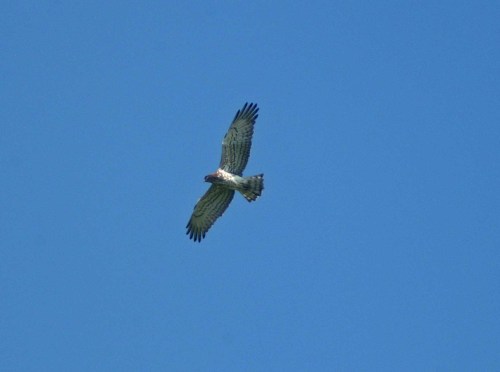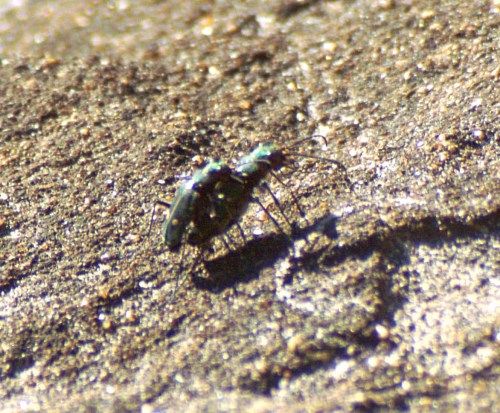26th February 2011
A very warm morning had built up to an unseasonably high temperature by the time I arrived for lunch at my friend’s house at Jimena. Before I even knocked on the door I had the camera out and pointed at butterflies and Violet Carpenter bees that were very strongly drawn to a flowering shrub at the front of the house. There were 2 Red Admirals, several Large Whites and numerous Carpenter bees, but it was also quite windy and very difficult to focus on them swaying around.
We had lunch sitting outside in the garden, debating where to head for to walk this afternoon. We settled on a walk along the pathway that follows the río Hozgarganta upstream through the Jimena valley, a walk we have done several times that is always interesting and enjoyable. Whilst eating we kept an eye on the sky; migration has been slow to get under-way this year due to the weather, so on a warm sunny afternoon, although the wind wasn’t blowing in a particularly helpful direction, we thought a few determined birds may make it across. Luckily for us we happened to be looking up as two Egyptian Vultures flew over, low down and in no particular hurry- so a good omen for the afternoon.
Looking both up and downstream from the bridge there were no signs of any wading birds, but in the alder and other small trees growing in front of the bridge, and in the tangle of undergrowth below there were a good number of small birds; Blackcaps singing, Greenfinches, a Chiffchaff and a Sardinian Warbler were all there.
- A stone outcrop sculpted and scoured clean and smooth, shows how high the river has been
Once past the houses and the domesticated area of the riverbank you can begin to better appreciate the more rugged and natural scenery created by the river, the rock formations and the wild flora. I spotted bright yellow flowers off to the side of the path and headed off for a closer look. I quickly found myself in a wet, muddy marshy area and was about to turn back, when I noticed little frogs were popping about all around me. The flowers were Lesser Celandines, as I’d hoped.
Leaving the frogs in peace and making my way back to the track, I caught sight of a small Lizard scuttling across a large rock.
We hadn’t walked far before spotting another, larger lizard; he had clearly lost the end of his tail at some point and although it had re-grown he will never regain his colourful scales.
We spotted birds hovering high up in the sky that we could make out as Kestrels and wondered if they may be Lesser Kestrels as there were two close together. There was still a fairly strong wind blowing and the birds were making good use of it, their wings were extended as though to hover, but holding them still they were able to maintain an almost motionless position for impressively long periods. As we watched one of the birds flew into a hollow in an outcrop of rock; as it happens this particular rock is one we have often commented on, as its shape and the hollow put us in mind of an animal’s raised head, mouth wide open…? Anyway, inside the hollow is a further smaller cavity and we located the Kestrel sitting on its edge. We continued watching as two more Kestrels appeared that seemed to have gone down on the other side of the outcrop. Now we had seen more than two birds we were happy to conclude that they were indeed Lesser Kestrels and that we had discovered their nesting place.
We continued on our walk enjoying the dramatic scenery and the warmth of the sun, until we reached a spot overlooking the river that looked like a pleasant place to sit. It was a good decision to stay still for a while, as it gave us the opportunity to fully appreciate our surroundings and to notice the details of it. We timed our break well too, we spotted raptors flying over, a Booted Eagle (light phase) and a Short-toed Eagle, the first individual of the latter species that either of us had seen so far this year. The Kestrels were very visible, flying back and forth over the ridge of hills in front of us and close enough for us to identify properly and confirm that they were indeed Lesser Kestrels.
There were more sightings of a Short-toed Eagle; we thought at first that we were seeing the same bird that was circling around, but then decided that was unlikely and it was more likely to have been three individual birds on passage.

Short-toed Eagle - The views we had today were of birds flying too high for me to photograph effectively, so this is 'one I made earlier'
Some plants are flowering now, most abundant was French Lavender growing amongst rocks and bushes of bright yellow broom.
As we moved off to begin our walk back I spotted a green Tiger Beetle scurrying over a rock. It stopped so I focused the camera on it and realised it was actually two beetles, a mating pair, showing the considerable difference in their sizes, the female being the largest.
Perhaps my favourite sighting of the day was of this male Serin, singing his socks off from the top of a shrub just a short distance away from us. He was in bright sunlight and very colourful.
- Griffon Vulture-Gyps fulvus
You do have to be quite unlucky not to have sightings of Griffon Vultures in this area, but we had especially good views of these magnificent birds today when five of them flew in a straggly line along a low ridge to the side of us. We have no way of knowing whether they were part of the local flock or just passing through, but either way they were, as always a dramatic sight.
Arriving back at where the town meets the river, the wild flora begins to blend into the cultivated and there are fruit trees growing that may once have been in a garden or orchard, but are now untended. This Avocado tree has grown so tall, we only realised what it was because there were fallen fruits beneath it. Looking up we saw a heavily-fruited branch high above us, overhanging the path. They looked perfect, what a shame they’ll probably be wasted.
What appears to be two trees here, an orange and a lemon, is in fact one tree. Apparently it was common practise to graft one of each onto a single rootstock so both could be grown more compactly in a small patio garden. This particular one seems to have got a little out of hand but has produced abundant quantities of fruit.
On the subject of fruit, this one is definitely one never to be eaten; it is the Apple of Sodom – Solanum sodomeum, a member of the Nightshade family and a fairly common plant on disturbed earth and waste spaces. The fruit looks attractive, but like all parts of the plant are very poisonous.

Back at the house, a lovely, very large Moorish Gecko sunbathed on the stem of a palm frond. Looks more like a baby alligator.
We got back to the house at about 6pm, admired the big gecko on the palm tree then took another cup of tea out into the garden. It was still very warm, the outside thermometer reading 19°C, 2° more than inside – Spanish houses are built to stay cool, even in the winter. Collared Doves, currently nesting in a tall cypress tree were very noisy and active, and there were a good few Barn Swallows flying around. Then the Cattle Egrets, having spent the day hunting in the nearby fields, began to pass overhead on their way to their night-time roost. There must have been at least a hundred of them, in parties of varying numbers and they were very close overhead. They looked so pretty, white birds tinted faintly pink by the lowering sun, against a still-blue sky. Last treat of the day was a Buzzard, flying so low it almost skimmed the roof.
































